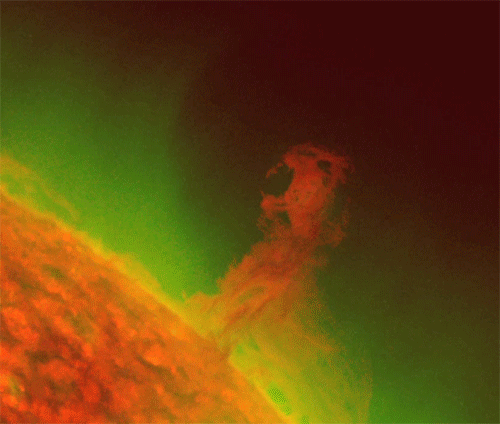
May 27, 2019
Throughout the visible Universe there are features described as twisted and “stringy”.
Previous Picture of the Day articles discuss formations cut in stone or puffed-out in clouds of ionized gas. Two such examples are solar prominences and the so-called volcanic eruptions on Jupiter’s moon, Io. How do those events relate to one another, especially when they occur in such disparate environments?
Every world in the Solar System is a charged body orbiting within a cloud of plasma, since the Sun emits a storm of particles called the solar wind. Plasma interacts with dust or gas no matter how hot or cold. Spacecraft sent to other planets, as well as satellites orbiting Earth, detect aurorae, lightning, and tornadoes. Volcanoes on Earth sometimes “spit lightning” from their vents. Global dust storms on Mars are fed by thousands of sky-high funnels. Farther into the Solar System, remote instruments find radio noise, electrified comets, spokes in Saturn’s rings and many other modes of electrical activity.
When plasma moves through a dust or gas, it tends to ionize the material and cause electric current to flow. Faraday demonstrated that when electricity pushes through any substance a magnetic field is created. One aspect of magnetism in electrified plasma is that it creates what are sometimes called “plasma ropes”. The magnetic field surrounds the plasma, confining it into a coherent system known as a Birkeland current. Birkeland currents are twisted current filament pairs that transport charge great distances through space following the ambient magnetic field in “force-free” mode.
As mentioned, the Sun’s energy travels through the Solar System in Birkeland currents. In reality, there is a storm of ions accelerating out of the Sun along gigantic filaments. Electric Universe advocates propose that galactic evolution can also be explained in terms of large-scale plasma discharges forming helices of coherent filaments. Why stars in galaxies tend to coalesce in long arcs like bright beads on a line is one of a hundred mysteries that conventional cosmology must confront. No gravity-only hypothesis can resolve the issue of star formation, in general, but the structure seen within the barred spirals and the tremendous elliptical whirlpools that congregate in million-light-year clusters continues to elude explanation.
Retired Professor of Electrical Engineering, Dr. Donald Scott, author of The Electric Sky, wrote about the way plasma acts in the Universe:
“Plasma phenomena are scalable. Their electrical and physical properties remain the same, independent of the size of the plasma. In a laboratory plasma, of course, things happen much more quickly than on, say, galaxy scales, but the phenomena are identical — they obey the same laws of physics…Electric currents flowing in plasmas produce most of the observed astronomical phenomena that remain inexplicable if we assume gravity and magnetism to be the only forces at work.”
Stephen Smith












